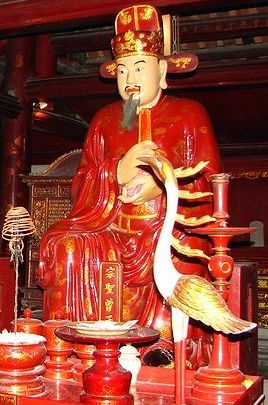
Content created: 2011-08-08
File last modified:
Go to bilingual display.

The Great Learning (Dà Xué 大学) has long had independent status as the shortest work in the Confucian Canon, although it is also a chapter in the Book of Rites (Lǐ Jì 礼记), one of the longest works in the Canon.

Although Chinese have traditionally attributed these texts to Confucius, the consensus today is that they were not written by him, but that they closely represent his views and his ways of reasoning. The author is now believed to be Zēng Shēn 曾参 (also pronounced Zēng Cān), who is often referred to as "Master Zēng" or Zēngzǐ 曾子) and to whom a lengthy supplementary commentary has always been attributed.
This page provides the whole of the Great Learning, reproduced from the classic scholarly translation published by James Legge in The Chinese Classics (1893-1895 ). (For an annotated listing of the contents of the Confucian Canon, click here.) In his original publication, Legge accompanies the text by extensive notes, and follows it with the traditional commentary attributed to Zēng Cān. These materials are omitted here.
(A more complete on-line file that includes the commentary may be had from Chinese Classics & Translations. For the commentaries, click on "Zengzi's comments on illustrious virtue" &c. at the top of the page on that site.)
1. What the Great Learning teaches is: to illustrate illustrious virtue; to renovate the people; and to rest in the highest excellence.
2. The point where to rest being known, the object of pursuit is then determined; and, that being determined, a calm unperturbedness may be attained to.
3. To that calmness there will succeed a tranquil repose. In that repose there may be careful deliberation, and that deliberation will be followed by the attainment of the desired end.
4. Things have their root and their branches. Affairs have their end and their beginning. To know what is first and what is last will lead near to what is taught in the Great Learning.
5. The ancients who wished to illustrate illustrious virtue throughout the kingdom, first ordered well their own States.
6. Wishing to order well their States, they first regulated their families. Wishing to regulate their families, they first cultivated their persons.
7. Wishing to cultivate their persons, they first rectified their hearts. Wishing to rectify their hearts, they first sought to be sincere in their thoughts.
8. Wishing to be sincere in their thoughts, they first extended to the utmost their knowledge. Such extension of knowledge lay in the investigation of things.
9. Things being investigated, knowledge became complete. Their knowledge being complete, their thoughts were sincere.
10. Their thoughts being sincere, their hearts were then rectified. Their hearts being rectified, their persons were cultivated.
11. Their persons being cultivated, their families were regulated. Their families being regulated, their States were rightly governed.
12. Their States being rightly governed, the whole kingdom was made tranquil and happy.
13. From the Son of Heaven down to the mass of the people, all must consider the cultivation of the person the root of everything besides.
14. It cannot be, when the root is neglected, that what should spring from it will be well ordered.
15. It never has been the case that what was of great importance has been slightly cared for, and, at the same time, that what was of slight importance has been greatly cared for.